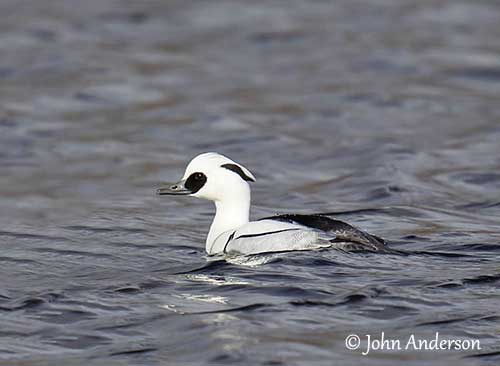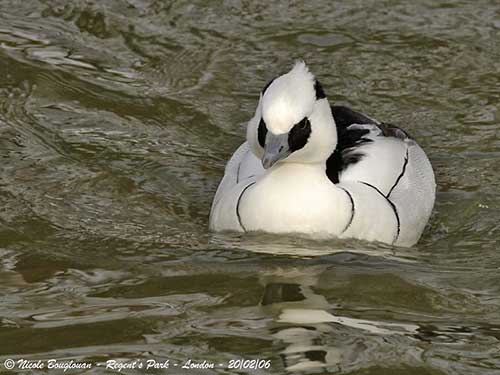
Fr: Harle piette
Ang: Smew
All: Zwergsäger
Esp: Serreta Chica
Ita: Pesciaiola
Nd: Nonnetje
Sd: salskrake
Photographers:
John Anderson
John Anderson Photo Galleries
Steve Garvie
RAINBIRDER Photo galleries & Flickr Rainbirder
Otto Plantema
Trips around the world
Nicole Bouglouan
Photographic ramble & My pictures on IBC
Text by Nicole Bouglouan
Sources:
HANDBOOK OF THE BIRDS OF THE WORLD vol 1 by Josep del Hoyo-Andrew Elliot-Jordi Sargatal - Lynx Edicions - ISBN: 8487334105
GUIDE DES CANARDS, DES OIES ET DES CYGNES – de Steve Madge - Delachaux et Niestlé - ISBN: 2603013769
THE HANDBOOK OF BIRD IDENTIFICATION FOR EUROPE AND THE WESTERN PALEARCTIC by Mark Beaman, Steve Madge - C.Helm - ISBN: 0713639601
THE COMPLETE BOOK OF BRITISH BIRDS – Written by “Royal Society for the Protection of Birds” experts - Préface de Magnus Magnusson - Michael Cady- Rob Hume Editors - ISBN: 0749509112
Wikipedia, the free encyclopaedia
Bird Web (Seattle Audubon Society)
Bird Words - The official site of Dominic Couzens, natural history writer
What Bird-The ultimate Bird Guide (Mitchell Waite)
Smew
Mergellus albellus
Anseriformes Order – Anatidae Family
INTRODUCTION:
The Smew is a small diving duck and the sole member of the genus Mergellus, closely related to the genus Mergus. However, from several authors, it might be closer to the genus Bucephala. This species sometimes hybridizes with the Common Goldeneye, as the females of both species have more or less similar appearance.
The Smew breeds by forested pools, lakes and slow rivers in the taiga of N Europe and Asia. But it winters mostly in estuaries, bays and sheltered coasts, and also on inland lakes. It is migratory and has a wide range.
The Smew is not globally threatened, but it is affected by habitat loss and degradation, and oil-pollution in coastal waters.

DESCRIPTION OF THE BIRD:
Biometrics:
Length: 38-44 cm
Wingspan: 55-69 cm
Weight: M: 540-935 g – F 510-650 g
The Smew adult male in breeding plumage is white with black mantle. There are two narrow black lines on each side of the breast. Greater wing-coverts and flight-feathers are black. Rump and tail are dark grey. The body sides are white with narrow pale grey vermiculations.
The head is white with black mask including lores and eyes. There are some black feathers on the nape, contrasting with the white, elongated crest feathers.
The short bill is grey. The eyes are dark reddish-brown. Legs and webbed feet are grey.
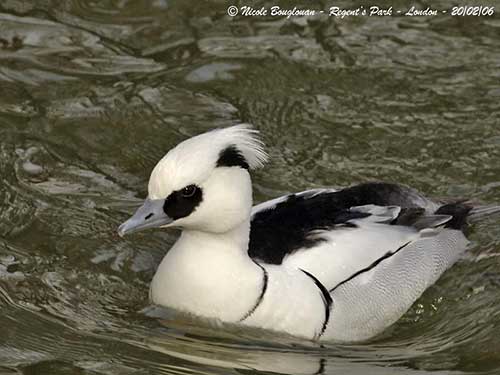
The male in eclipse resembles female but with black upperparts and white patch on median wing-coverts.
The adult female (also named Redhead Smew) has rufous-brown nape and hindneck. Throat and lower cheeks are white. Upperparts and tail are grey, whereas the wings show less white pattern than in male. Breats and flanks are mottled grey, becoming darker on rear flanks.
The juvenile/immature resembles female but it has dark brown lores (not black). The eyes are duller, mostly grey-brown.
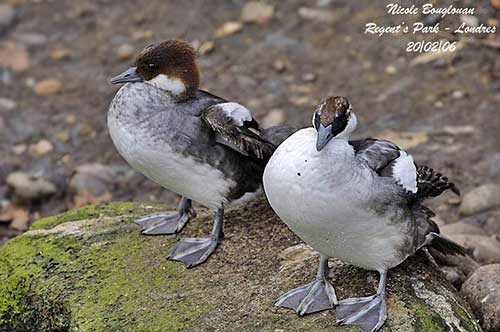
RANGE:
The Smew breeds in N Europe and Asia, from Scandinavia E in a band extending to E Siberia (Kamchatka).
It winters in both North and Baltic Seas, and from C Europe E to Black Sea and Caspian Sea, in E China, Korea and Japan, and as far E in W Aleutian Islands.
HABITAT:
The Smew breeds in the northern taiga by freshwater lakes, pools and slow-flowing rivers. It favours the lowland riverine forests.
During winter, it is found on open inland lakes and in sheltered coasts, estuaries and bays.
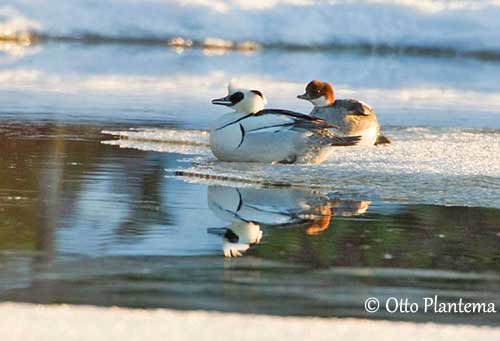
CALLS AND SONGS: SOUNDS BY XENO-CANTO
The Smew is more vocal during the courtship displays and when threatened. It gives a sharp “krrr” note and may produce low croaks and weak, hissing whistles during the displays. The female utters mainly grating, growling notes.
BEHAVIOUR IN THE WILD:
The Smew feeds on aquatic insects and small fish.
It forages by diving from the surface. It is able to swim underwater when pursuing a prey. Once the prey is located, it catches it thanks to the hook-tipped and serrated edges of the bill. Then, the fish is brought to the surface where it is swallowed head first.
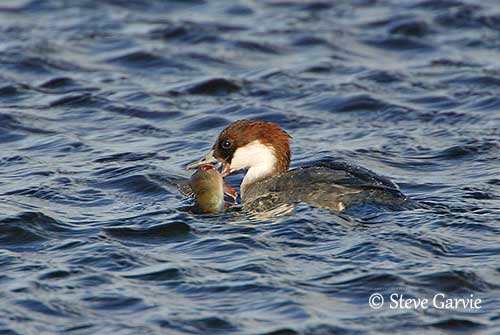
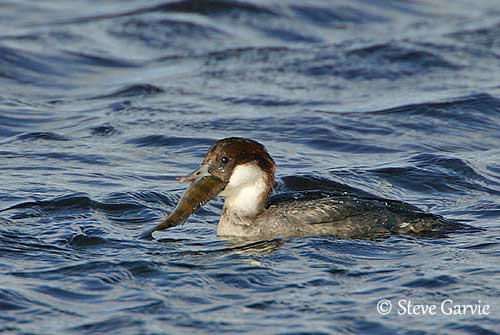
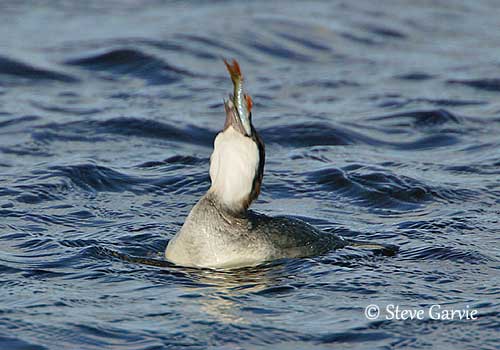
The Smew male performs courtship displays as soon as the end of the winter, before the return migration.
The displays include upwards stretching of the head with erect crest. The male also performs wing-flapping and crest-raising, display drinking and preening movements. They are monogamous during a season.
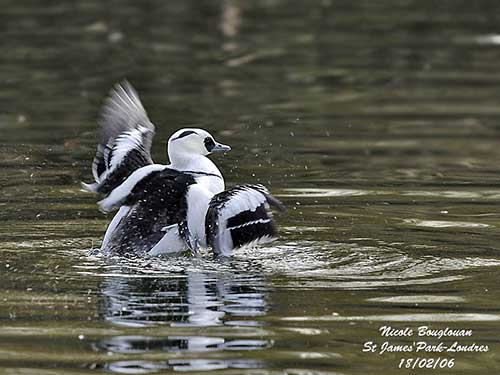
The Smew is migratory and leaves the breeding grounds from September to early October. Arrivals in North Sea wintering areas occur in December or even January.
The spring migration starts in March, but some birds may leave the wintering grounds only in April/May.
Vagrants to North America and mainly in winter have been recorded in Alaska and S to California, and more rarely across the northern states of USA and the southern provinces of Canada.
The Smew migrates in groups, flying in an oblique line and V-formation. The flight is direct, fast and noiseless with rapid wingbeats.
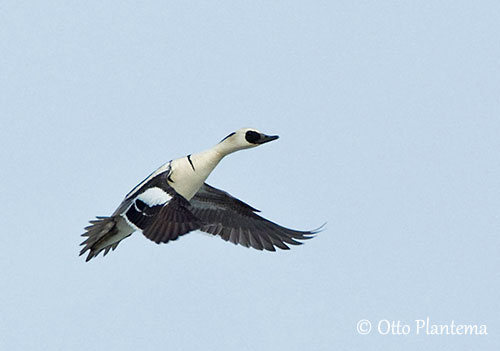
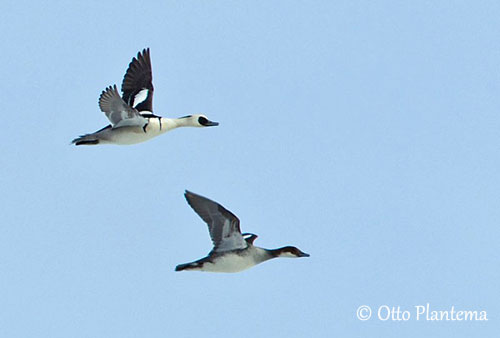
REPRODUCTION OF THIS SPECIES:
The breeding season starts in April/May in S of range, and from mid-May to mid-June in N.
The Smew is solitary nester or breeds in loose groups. This species nests in three hollows, sometimes an abandoned hole by a woodpecker. It also accepts nest-boxes. In tree, the nest is at least 10 metres above the ground. The hole is usually lined with feathers and down.
The female lays 6-9 cream-coloured to pale buff eggs. She incubates alone during 26-28 days, while the male abandons her for moulting.
At hatching, the chicks have sooty black down and white underparts. They are precocial and become sexually mature at two years old.
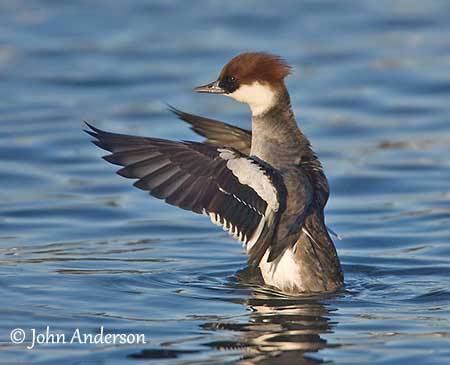
PROTECTION / THREATS / STATUS:
The Smew is affected by habitat loss and degradation, involving the lack of suitable nesting sites. It is vulnerable to oil pollution in coastal waters, and also threatened by hunting pressure during the migration.
The natural predators include the American Mink, the Long-legged Buzzard, the Rough-legged Buzzard, the Peregrine Falcon, the Merlin and the Hen Harrier.
The global population is estimated to number at least 130,000 individuals (2015). It is suspected to be decreasing, but some populations are increasing.
However, the Smew is not globally threatened and currently evaluated as Least Concern.
